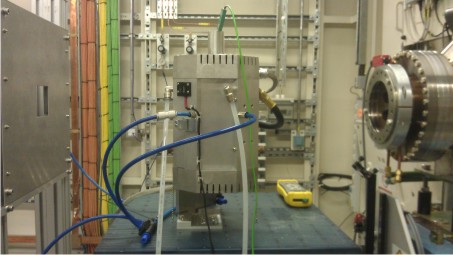Applications of Layered Double Hydroxides
Layered double hydroxides (LDHs) are compounds with the generic formula: [MII2MIII(OH)6]X·yH2O. LDHs may be formed with all dipositive metal ions from Mg2+ to Zn2+, and all transition metal trivalent ions (except Ti3+, owing to the relative instability of this oxidation state for Ti). There also exists an unusual family of LDHs containing a 1+ cation, with the formula [LiAl2(OH)6]X·yH2O. LDHs contain positively charged metal hydroxide layers with charge balancing X anions located between the layers (see figure below).
The generalised structure of an LDH. Positively charged layers are shown in blue, and interlayer anions in green.
The primary reason for interest in LDHs is because the anion X can easily be replaced by a wide range of alternate anions, making them extremely attractive as ion exchange materials. The group is interested in a wide variety of aspects of LDH chemistry, with a particular focus on:
- Synthesis of new LDHs (J. Mater. Chem., 2004, 14, 2369).
Novel LDHs of the composition [MIIAl4(OH)12](NO3)2·yH2O (M = Ni, Co, Cu, Zn) can be produced if gibbsite (Al(OH)3) is activated by ball milling and then subjected to a hydrothermal treatment with concentrated metal nitrate solutions. Al(OH)3 after grinding is shown on the left, and the idealised structures of the LDHs produced on the right.
- Using novel synthesis routes to produce novel morphologies (Chem. Commun., 2006, 287; J. Am. Chem. Soc., 2005, 127, 17808):
Hydrophobic layered double hydroxide particles with a single layer structure can be successfully synthesised in a reverse microemulsion system, and atomic force microscopy has proven a powerful tool for the study of these delicate nanoparticles. (TOP) An AFM image of Mg2Al-dodecyl sulfate particles synthesised by reverse microemulsion method. (BOTTOM) a cross-sectional analysis of the labelled particles showing the dimensional profiles.
- Storage and controlled release of functional anions (e.g. drugs, pesticides, flavours) from LDH matrices (Ind. Eng. Chem. Res., 2009 48, 10196).
A range of functional anions can be intercalated into LDHs, and their release triggered ‘on demand’. These include drugs such as ibuprofen (left) and tartrazine (right). The release of tartrazine from [LiAl2(OH)6]-tartrazine (black), [Mg2Al(OH)6]-tartrazine (red) and [Mg2Fe(OH)6]-tartrazine (blue) in a 0.01M CO32- solution is shown below.
- Shape-selective intercalation of isomeric anions (J. Mater. Chem. 2006, 16, 1231).
When reacting LDHs with isomeric mixtures of anions (for instance, 1,2- and 1,4-benzenedicarboxylate, shown above) we observe a very high degree of selectivity (>99% of the intercalated benezendicarboxylates are the 1,4- isomer). In some cases, changes of temperature and reaction solvent system lead to changes in selectivity.
- Mechanistic studies of the nanoscopic processes involved in intercalation (Chem. Mater. 2004, 16, 975; Chem. Mater. 2005, 17, 2632).
Using the in situ apparatus described above, we have shown that the intercalation of a number of carboxylates and phosphonates into the hexagonal polymorph of [LiAl2(OH)6]X·yH2O (X = Cl, Br, NO3) proceeds via a novel second stage intercalate. The starting material is shown on the left above, the intermediate centre, and the fully-exchanged product on the right. Typical in situ data are shown below.
In-Situ Diffraction Studies
Our in situ diffraction studies are primarily undertaken using Beamline I12 (JEEP) at Diamond Light Source. This experimental station possesses the key properties required for in situ energy-dispersive X-ray diffraction(EDXRD) measurements; the wide photon energy range (50 – 150keV) coupled with the high photon flux makes conditions ideal for penetrating thick reaction vessels to probe large sample volumes.
We have recently developed a new chemical reaction cell for in situ studies on JEEP: the Oxford-Diamond In Situ Cell (ODISC). It has a number of important features that help us to simulate reaction laboratory conditions, whilst simultaneously allowing us to probe our reacting mixture with the X-ray beam. The furnace, shown below, heats samples to temperatures above 1000°C and can incorporate a range of sample vessels required to study a broad spectrum of solid-state chemistries.

Use of this reaction apparatus, and variants of it, has allowed a wide variety of reactions to be probed and kinetic parameters calculated. High intensity EDXRD data with excellent resolution makes it possible to distinguish reflections from starting material phases, any intermediates, and the final product. Low temperature studies up to 100°C have been undertaken into intercalation reactions of LDHs, high temperature molten salt synthesis reactions have been probed at 1000°C, and the crystallisation of MOFs has been studied in hydrothermal conditions up to 250°C.
